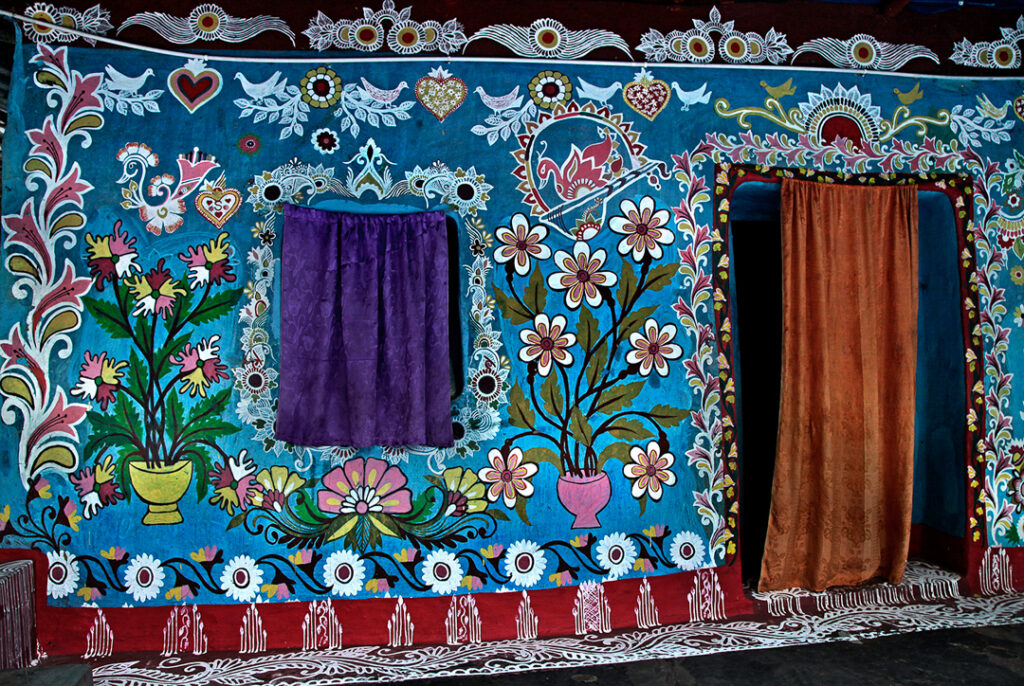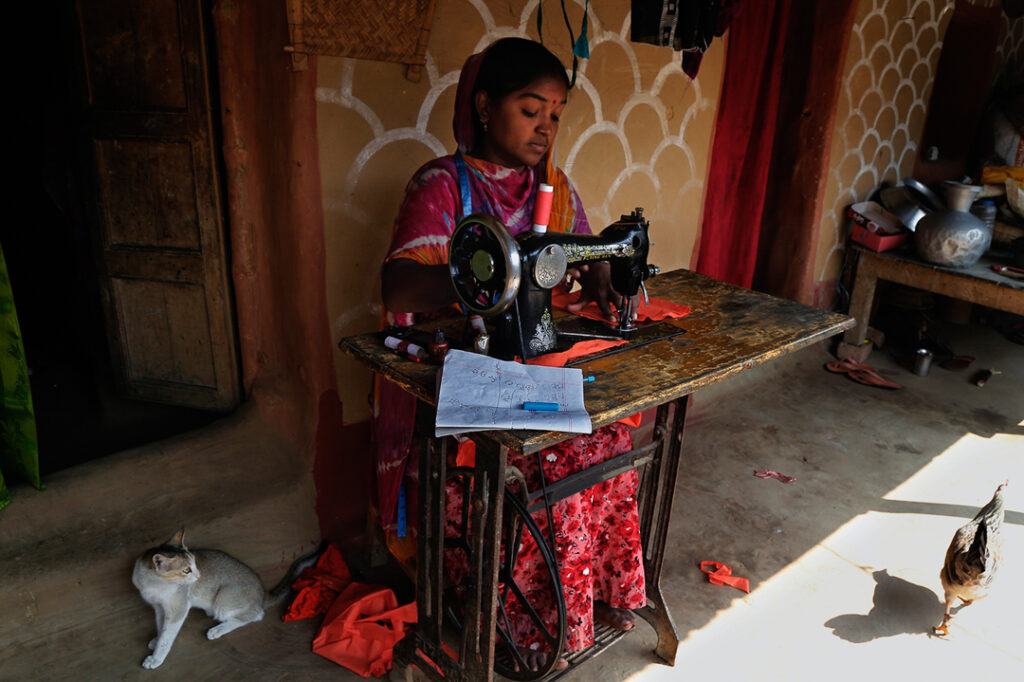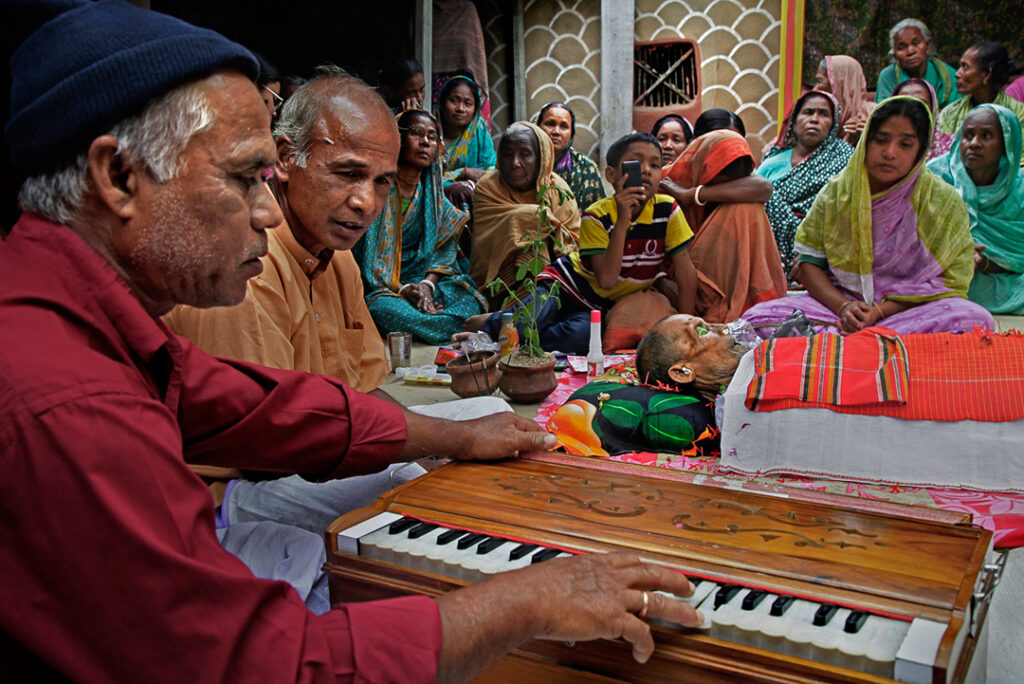
Mohammad Shahnewaz Khan describes the tradition of house decoration practiced by Hindus that is appreciated by the majority Muslim population.
Tikoil is a village of Chapainawabganj in Bangladesh which is otherwise known as Alpana village, due to its traditional art called Alpana, which is also ritual painting. Alpana refers to colorful motifs, sacred art or painting done with hands.
The mud walls of Alpana houses are covered with colorful motifs of birds, animals, trees, and flowers, which tell the story of a village. Nature’s beauty is displayed on these walls in brilliant colors, while the drawings of cattle carts and oil lamps reflect a young village girl’s life, which is like a reflection of rural Bangladesh.
Alpana is a unique form of esthetical expression of local values, tradition, culture, emotions, myth, folk stories, lifestyle perpetuated by the female-male for a long time. It also tells the stories of peaceful coexistence and unity among different communities. The ritual and ancient folk arts of Bengal (including Alpana) were originally a part of the pre-agricultural communities, which supplied sufficient crops and expelled evil spirits. Basically, this tradition has been kept in the hands of women. They have perpetuated this tradition on the walls of the house year after year and are determined to carry this tradition from generation to generation. They are devotees of Radha-Krishna, believers in Hinduism. Every wall in this Alpana village is a canvas and people are Alpana artisans.
According to 65-year-old Dhiren Burman; who is the head and priest of the Radha Govinda Temple in Tikoil, “Alpana is our tradition, which has become a part of our religious rituals. During our religious and social festivals; my community paints their houses with Alpana. With the aggression of modern civilization; clay houses are disappearing; traditions are being lost day by day. But I’m hopeful that our future generations will carry on the tradition of Alpana drawing. We are determined to perpetuate this tradition from generation to generation. I’ve one son, three daughters and many grandchildren, among whom I have firmly spread this tradition. Although women are mainly Alpana artists, there are many male Alpana artists also in our village. We are unique because of this tradition.”
Before; local red clay, chalk, turpentine oil and rice-soaked white paint were used to draw Alpana. To make Alpana last longer, they were mixed with various natural tree branches, but now Alpana is painted with the colors available in the market. According to the villagers, just as it brings holiness to the home, it also creates an opportunity for everyone in the family to enjoy the home.
- The name of this house is “Alpona Bari-Alpona House”. The “Alpona Village” is named because of this “Alpona House”. The owner of this house is named “Daykhon Barman”, who is a pioneer of Alpona tradition in her village. The house walls are covered with colourful motifs of birds, animals, trees, and flowers. These motifs, traditionally known as alpona, tell the story of a village. Though the Hindu houses of the village host Alpona, it got its name “Alpona Gram”/”Alpona Village” because of the exceptional talent of a woman named Daykhon Barman. This photo was taken on 11 November 2021, in Tikoil, Nachol upazila of Chapainawabganj District, Bangladesh.
- A wall painting inside the “Alpona House”, which has been painted throughout Alpona by the exceptional talent of a woman named “Daykhon Barman”, who is the owner of this house and pioneer of Alpona tradition in her village. This wall painting is just like a pure reflection of rural Bangladesh. The “Alpona Village” is named because of this “Alpona House”. This photo was taken on 12 November 2021, in Tikoil, Nachol upazila of Chapainawabganj District, Bangladesh.
- An overall view of a house named “Alpana House”. The “Alpana Village” is named because of this “Alpana House”, because of the exceptional talent of a woman named “Daykhon Barman”, who is the owner of this house and pioneer of Alpana tradition in her village. The house walls are covered with colorful motifs of birds, animals, trees, flowers and by portraits of eminent libertarian leaders, humanist poets, etc. In the picture, Daykhon Barman is seen doing daily work in the front yard of her Alpana House. This photo was taken on 11 November 2021, Alpana Village in Tikoil, Nachol upazila, Chapainawabganj, Bangladesh.
- Daily life in Alpona village, every wall in this village is a canvas and the people are Alpona artisans. 50 years old Basanti has one son and two daughters. Her children are married and son lives in Dhaka with his wife, now she takes care of her son’s children. This photo was taken on 13 November 2021, in Tikoil, Nachol upazila of Chapainawabganj District, Bangladesh.
- A Muslim old man standing in front of Alpana art, in a house of Alpana village. Although drawing images of animals and birds is prohibited and avoided in Muslim houses, but, among Muslims in Alpana village, there is no tendency to avoid houses rich in Alpana, indicating the social coexistence of the two communities. Visitors from all over Bangladesh and the world irrespective of religion and caste come to this village to know and see this folk art, mostly from the Muslim community. Although Muslims are the majority in this village, Hindus and Muslims live together peacefully. Muslim houses are observed between two houses of Hindu Burmans involved in this Alpana art. Even in the fields, shops or markets, both communities can be seen working shoulder to shoulder. Beef is not found in any of the hotels in this village and in the neighboring bazaars, cows are not slaughtered and especially beef is not kept in shops, as a sign of respect and sincerity towards the Hindus of the village, because Hindus worship cows as mother. This Alpana village has set a unique example of tradition, religious & communal harmony. This photo was taken on 17 February 2022, Alpana Village in Tikoil, Nachol upazila of Chapainawabganj, Bangladesh.
- Bedroom view inside a house in Alpana village, where Alpana art is painted. Every wall in this village is a canvas and the people are Alpana artists. They have perpetuated this tradition and culture on the walls of the house year after year in the lineage and they are determined to carry this tradition from generation to generation. This photo was taken on 11 November 2021, Alpana Village in Tikoil, Nachol upazila, Chapainawabganj, Bangladesh.
- An interior architectural view of ‘Alpana House’ in the ‘Alpana village’. Every wall in this ‘Alpana village’ is a canvas and people are Alpana artisans. According to Alpana villagers: “We are determined to perpetuate this tradition from generation to generation”. The third generation Alpana artist Sathi Burman is seen in the photo. This photo was taken on 17 February 2022, Alpana Village in Tikoil, Nachol upazila, Chapainawabganj, Bangladesh.
- Shyamal Burman’s 14-year-old daughter Sushmita Burman is in class 10, who is seen in the picture drawing Alpana in the front yard of their house, with her grandmother Sumitra Barman. Sushmita’s marriage proposals are coming regularly. Sushmita’s grandmother regularly enlivens the courtyard of the house with Alpana’s touch in order to marry off her granddaughter to a good family and to showcase the beauty and nobility of their home to the prospective groom’s family and Sushmita’s eyes have caught the matter well, that’s why she’s upset. The old men and women of the village like the bride and groom of that house after seeing the sweetness of the Alpana of the house and this Alpana plays an important role in expressing the social status. Generally, this Alpana tradition has been kept in the hands of women; from generation to generation they have kept this tradition on the walls of the houses and in the courtyards for years. This photo was taken on 19 February 2022, Alpana Village in Tikoil, Nachol upazila, Chapainawabganj, Bangladesh.
- This house in ‘Alpana village’ is called ‘Alpana House’, college student ‘Sathi Burman’ is seen worshiping inside the “Alpana House” and Sathi Burman is grandson of ‘Deikhon Burman’, who is a pioneer artist of Alpana art and tradition of Alpana village. At present this Alpana Art; a representative of the third generation, like: ‘Sathi Burman’, is leading the way. Generally, this Alpana tradition has been kept in the hands of women; from generation to generation they have kept this tradition on the walls of the houses and in the courtyards for years. This photo was taken on 17 February 2022, Alpana Village in Tikoil, Nachol upazila, Chapainawabganj, Bangladesh.
- 50 years old Basanti has one son and two daughters. Her children are married and son lives in Dhaka with his wife, now she takes care of her son’s children. Soon her son will come home with his wife; as a result, the arrival of guests will increase. For that reason; she decided to decorate the house in a new way through Alpona to beautify her house. This photo was taken on 13 November 2021, in Tikoil, Nachol upazila of Chapainawabganj District, Bangladesh.
- Daily activities, daily colorful life of the women of Alpana village. They are very hardworking, they work from morning to evening with joy. This photo was taken on 16 February 2022, Alpana Village in Tikoil, Nachol upazila of Chapainawabganj District, Bangladesh.
- Alpana art drawn on clay walls, inside a house in the Alpana Village. Every wall in this village is a canvas and the people are Alpana artists. They have perpetuated this tradition and culture on the walls of the house year after year in the lineage and they are determined to carry this tradition from generation to generation. This photo was taken on 12 November 2021, Alpana Village in Tikoil, Nachol upazila, Chapainawabganj, Bangladesh.
- Shiuli Burman is a housewife of Alpana village, her hobby is sewing, she also earns some extra money by sewing in her leisure time. The houses of these simple-ordinary rural village people are colorful, because their minds are also colorful. Every wall in this village is a canvas and the people are Alpana artists. They have perpetuated this tradition and culture on the walls of the house year after year in the lineage and they are determined to carry this tradition from generation to generation. This photo was taken on 19 February 2022, Alpana Village in Tikoil, Nachol upazila, Chapainawabganj, Bangladesh.
- Alpana village elder, 106-year-old Khorgershor Burman passed away, villagers gather around his dead body in Alpana village and perform rituals activities. This photo was taken on 13 November 2021, Alpona Village in Tikoil, Nachol upazila, Chapainawabganj, Bangladesh.
- 106-year-old village elder, Khorgershor Burman’s body being taken to crematorium for cremation and Alpona House is seen just behind the dead body, where “Alpona House” has been written in Bengali language on the upper side of the house. The old will die and the new will be born, in the same way; the villagers are determined to perpetuate this tradition art Alpana from generation to generation. This photo was taken on 13 November 2021, Alpona Village in Tikoil, Nachol upazila, Chapainawabganj, Bangladesh.
Now Alpana is expensive for the villagers, many people draw just part of their houses. Whatever, at least they keep a touch of Alpana in the houses. They usually decorate their houses with Alpana during religious festivals and other festivals like Harvest festival, New Year and weddings. Old men and women used to like the bride and groom of that house after seeing the sweetness of Alpana of the house. Many newlyweds come to shoot their post-wedding photos there. The village is even popular as a movie shooting spot.
Although drawing images of animals and birds is prohibited and avoided in Muslim houses, among Muslims in Alpana village, there is no tendency to avoid houses rich in Alpana, indicating the social coexistence of the two communities. Visitors from all over Bangladesh and the world irrespective of religion and caste come to this village to know and see this folk art, mostly from the Muslim community. Although Muslims are the majority in this village, Hindus and Muslims live together peacefully. Muslim houses are observed between two houses of Hindu Burmans involved in this alpana art. Even in the fields, shops or markets, both communities can be seen working shoulder to shoulder.
Beef is not found in any of the hotels in this village and the neighboring bazaars. Cows are not slaughtered and especially beef is not kept in shops, as a sign of respect and sincerity towards the Hindus of the village, because Hindus worship cows as mother. This Alpana village has set a unique example of tradition, religious & communal harmony.
About Mohammad Shahnewaz Khan
 Mohammad Shahnewaz Khan was born in Chittagong, Bangladesh, in 1984 and based there. He has a Diploma in photography and a professional degree in photography, subsequently undertaking many masterclasses and mentoring programs in the fields of photojournalism and documentary photography. In 2015, he received a scholarship from Syracuse University, USA. Beyond this, he has studied a diverse range of subjects including philosophy, history, literature, poetry, song, dance, and acting in a process of lifelong learning. He is a Humanist Documentary Photographer, Curator, Educator, social activist, works as a freelance photojournalist since 2004, and also sees himself as a self-taught artist. In 2016, he founded the Voice of Humanity and Hope Photography Institute (VOHH), subsequently initiating the VOHH Foundation, and the VOHH FOTO FEST. Shahnewaz has won 500 international awards; his photo series have been featured in over 500 International journals, in print media and TV shows worldwide and his photographs have featured in exhibitions in 100 countries worldwide in many prestigious institutions and events. His long-term documentary projects have been widely used for teaching and research in universities and institutions in Europe and the USA, as well as around the world. He lives and works in Chittagong.
Mohammad Shahnewaz Khan was born in Chittagong, Bangladesh, in 1984 and based there. He has a Diploma in photography and a professional degree in photography, subsequently undertaking many masterclasses and mentoring programs in the fields of photojournalism and documentary photography. In 2015, he received a scholarship from Syracuse University, USA. Beyond this, he has studied a diverse range of subjects including philosophy, history, literature, poetry, song, dance, and acting in a process of lifelong learning. He is a Humanist Documentary Photographer, Curator, Educator, social activist, works as a freelance photojournalist since 2004, and also sees himself as a self-taught artist. In 2016, he founded the Voice of Humanity and Hope Photography Institute (VOHH), subsequently initiating the VOHH Foundation, and the VOHH FOTO FEST. Shahnewaz has won 500 international awards; his photo series have been featured in over 500 International journals, in print media and TV shows worldwide and his photographs have featured in exhibitions in 100 countries worldwide in many prestigious institutions and events. His long-term documentary projects have been widely used for teaching and research in universities and institutions in Europe and the USA, as well as around the world. He lives and works in Chittagong.

















Comments
Thank you Mohammad Shahnewaz Khan for your insight and sharing information about the unique Alpana tradition.
So lovely to read about communal harmony in this area reflected in Alpana . Thank you Mohammad.